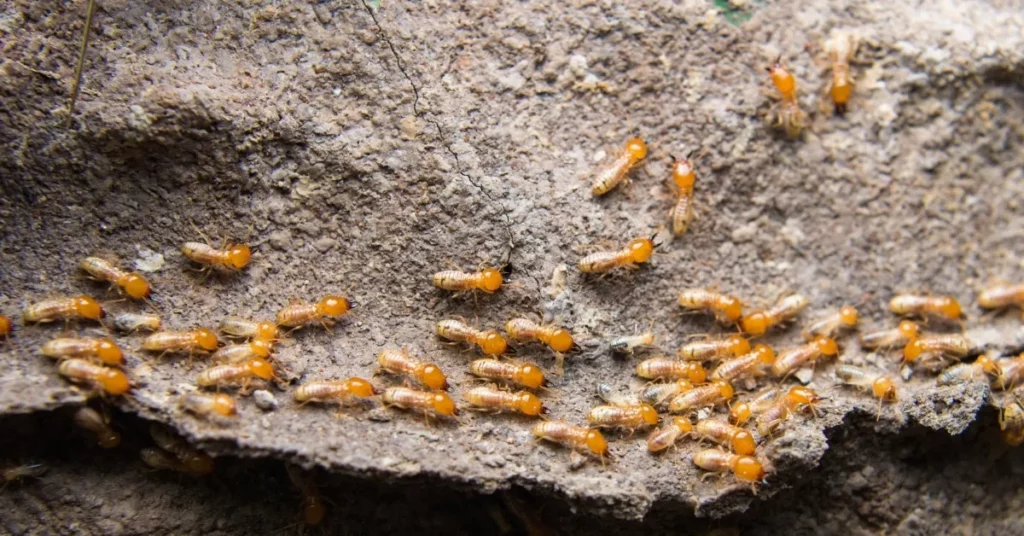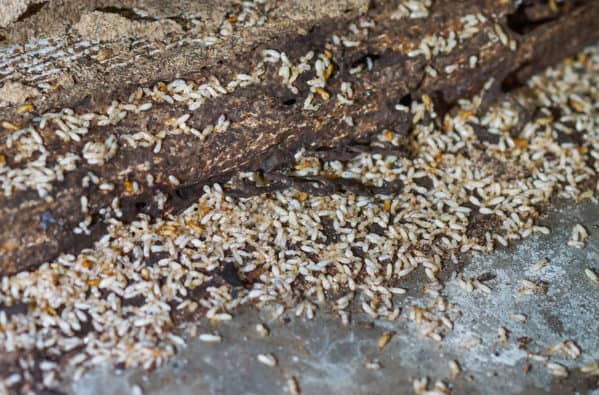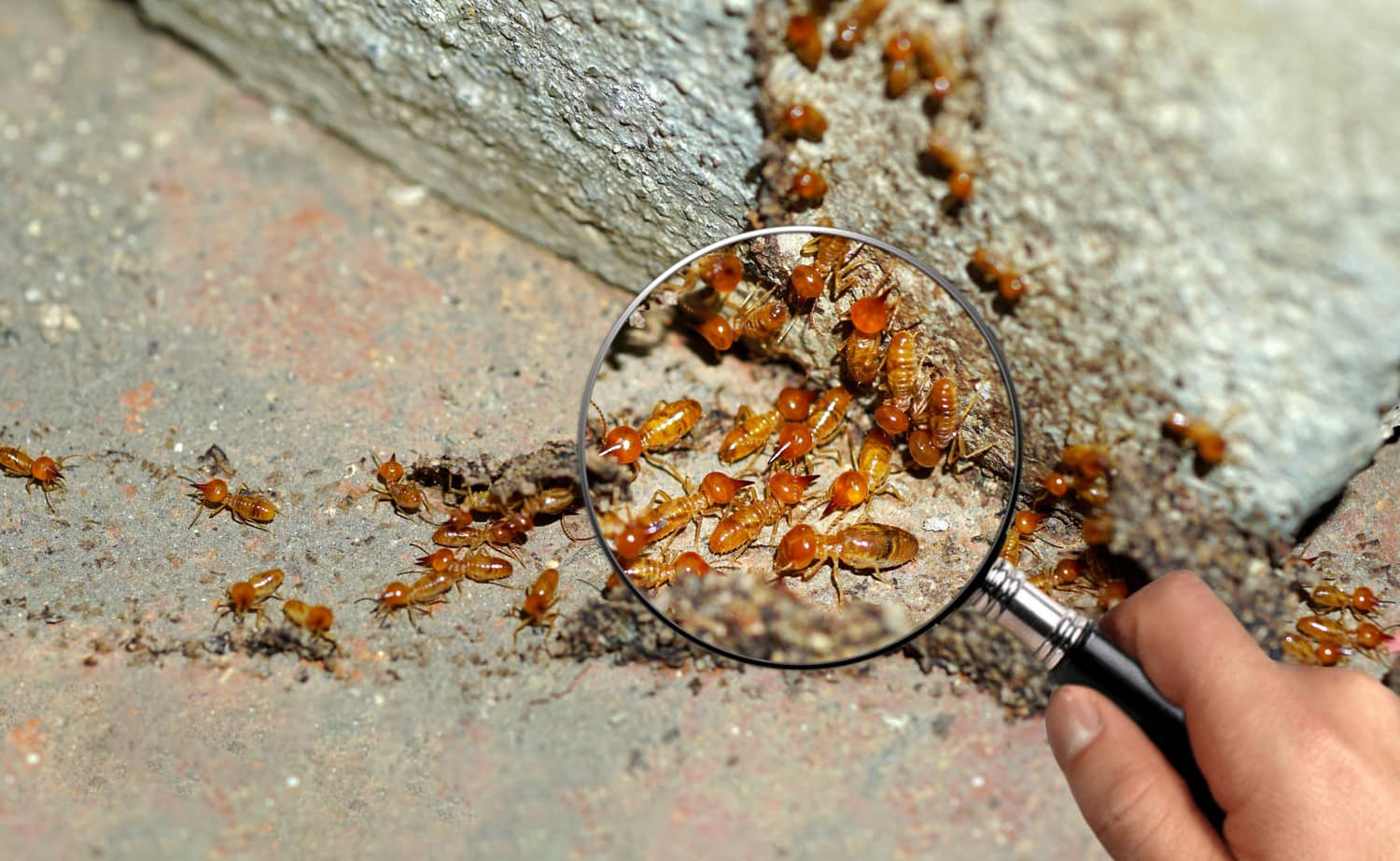Termites typically come from underground colonies in the soil or nearby nests. They can also enter homes through wood-to-soil contact or by flying in as reproductive swarmers from existing colonies.
Here’s what attracts the Termites to come to your Home,
- Excessive moisture, whether from leaks or poor drainage, can attract termites into your home.
- Termites are naturally drawn to cellulose-rich materials like wood, making any wooden structures or items susceptible to infestation.
- Warm and dark environments within your home can appeal to termites seeking shelter.
- Cracks and gaps in your home’s foundation provide entry points for termites to invade.
- Outdoor lighting near your home can attract swarming termites during their reproductive flights.
- Proximity to soil and vegetation, such as trees and shrubs, can create pathways for termites to access your house.
Natural Habitat of Termites

Termites have natural origins in various habitats:
Exploring Origins:
- Termites originated around 250 million years ago.
- They evolved from wood-eating cockroaches.
Habitat Types:
- Termites naturally occupy ecosystems such as forests, savannas, and grasslands.
- They play essential roles in breaking down dead plant material.
Influencing Factors:
- Moisture: Termites are drawn to areas with ample moisture.
- Wood Source: They seek cellulose-rich materials like wood.
- Temperature: Termites thrive in warm climates.
Understanding these factors helps us prevent infestations in our homes.
Termite Colonies and Reproduction
Termites originate from intricate colonies featuring a caste system. This system consists of workers, soldiers, and reproductive.
Termite Caste System:
- Workers (90-95% of the colony) handle tasks like foraging and feeding the colony.
- Soldiers (1-2%) defend against threats, often with powerful jaws.
- Reproductives (king and queen) are responsible for colony growth.
Colonization and Population Growth:
- Termites often start new populations by forming secondary colonies near the primary nest.
- Colonies range from a few thousand to several million individuals.
Reproduction and Life Cycle:
- A mature colony produces winged reproductive termites called alates or swarmers.
- Alates leave the nest in large swarms, seeking mates.
- After mating, they shed their wings and form new colonies.
- The queen lays eggs, and the colony grows in numbers over time.
- This well-organized system ensures the persistence and expansion of termite populations.
Factors that Attract Termites to Human Structures
Termites are drawn to human-built structures due to certain environmental factors and conditions. In this section, we will explore why termites find our homes and buildings appealing, along with common elements that attract them.
A. Understanding the Appeal of Human-Built Environments for Termites
Food Sources: Termites are primarily attracted to cellulose, a key wood component. Human structures often provide a rich source of cellulose in the form of wooden beams, furniture, and even paper.
Shelter and Protection: Termites seek shelter from predators, harsh weather conditions, and natural elements. Human-built structures offer them the ideal refuge, with the warmth and protection they need to thrive.
Moisture: Termites are highly dependent on moisture for survival. Damp environments within buildings, whether due to leaks, poor drainage, or humidity, provide an attractive habitat for termites.
B. Common Conditions and Elements that Attract Termites to Homes and Buildings
Wooden Foundations and Structures: The presence of wooden foundations, structural components, and building materials make homes and buildings particularly appealing to termites.
Subterranean termites, in particular, can easily access and consume wooden elements.
Soil-to-Wood Contact: Termites can tunnel through the soil to access wooden structures. Wood directly contacting the soil provides a convenient entry point for termites.
This occurs frequently with deck posts, fence posts, and untreated wood in contact with the ground.
Mulch and Landscaping: Using mulch and wood-based landscaping near the foundation can create a bridge for termites to access the structure. Termites can tunnel through mulch to reach the wooden components of your home.
Moisture Accumulation: Termites are attracted to moisture-rich environments. Leaky pipes, faulty drainage, or improper ventilation can lead to moisture buildup within the structure, making it more inviting to termites.
Cracks and Voids: Gaps, cracks, and cavities within walls and foundations provide hidden pathways for termites to move around. They can exploit these openings for shelter and movement.
Neglected Maintenance: Homes and buildings with poor maintenance are more likely to have conditions conducive to termite infestations. Failure to address leaks, wood rot, or damaged wood can create an environment that attracts termites.
Warm Climates: Termites are more prevalent in warm, tropical, and subtropical regions. In these areas, homes and buildings are at higher risk of termite infestations due to the year-round favorable conditions.
In summary, termites are drawn to buildings because they find plenty of food, shelter, and moisture there.
Factors like wooden components, soil-to-wood contact, landscaping choices, and poor maintenance can create conditions that make homes and buildings highly appealing to termites.
Prevention and Control Measures

A. Proactive Steps to Prevent Termite Infestations
Maintain Proper Ventilation:
- Ensure good airflow in crawl spaces and attics to reduce moisture buildup.
- Repair any damaged roof or plumbing to prevent leaks.
Remove Wood-to-Soil Contact:
- Termites can easily access wood if it touches the soil.
- Create a gap between soil and wooden structures like decks and fences.
Regular Inspections:
- Schedule annual termite inspections by a pest control professional.
- Look for termite signs like mud tubes, discarded wings, or damaged wood.
B. DIY Options for Termite Prevention
Termite-Resistant Wood:
- Use pressure-treated or naturally termite-resistant wood for construction projects.
- These woods are less appealing to termites.
Soil Treatment:
- Use liquid termiticides around your home’s perimeter in the soil.
- This creates a barrier that repels termites.
C. Professional Solutions for Termite Control
Termite Baiting:
- Pest control professionals can install bait stations around your property.
- Termites consume the bait and bring it back to the colony, ultimately eliminating the colony.
Soil Barrier Treatment:
- Professionals can apply liquid termiticides to create a protective barrier around your home.
- This prevents termites from entering or leaving the structure.
Fumigation:
- In severe infestations, fumigation may be necessary.
- A tent is placed over the structure, and gas is released to eliminate termites.
In conclusion, understanding the origins and behavior of termites is crucial in preventing and controlling infestations.
Proactive measures, such as proper ventilation and removing wood-to-soil contact, can be complemented by DIY options like termite-resistant wood and soil treatments.
FAQs
Where do termites come from?
Termites originate from various sources, but most commonly, they come from underground colonies in the soil. They can also enter homes through wood-to-soil contact or by flying in from nearby nests.
Do termites come from trees?
Termites can infest trees, but they primarily come from the ground. They establish colonies in soil and then forage for wood, which can include trees if they are nearby.
Can termites come from mulch or firewood?
Yes, termites can be found in mulch or firewood if the materials were in contact with the ground or had an existing termite infestation. They are attracted to the moisture and cellulose content of these materials.
Where do flying termites come from?
Flying termites, also known as swarmers, come from established termite colonies. They are reproductive termites that leave their nest to find a mate and start new colonies.
Are termites native to certain regions?
Termites are found worldwide, but the specific species and prevalence can vary by region. Some regions, particularly tropical and subtropical areas, have a higher concentration of termite species.
Can termites come from neighboring houses?
Yes, termites can spread from neighboring houses if they have access points like cracks in foundations or shared soil. They can travel through the soil and infest nearby structures.
Do termites come from moisture issues in homes?
Termites are attracted to moisture, so homes with water leaks or excessive humidity may be more susceptible to infestations. However, termites primarily come from external colonies.
Can termites come from furniture or wooden items brought into the house?
Yes, termites can come from furniture or wooden items brought into the house if those items were already infested or in contact with infested wood.
Where do Drywood termites come from?
Drywood termites create colonies within the wood they infest, so they don’t come from the ground like subterranean termites. They are usually found within the wood they are damaging.
Do termites come from DIY termite treatments?
No, termites do not come from DIY termite treatments; these treatments are intended to prevent or eliminate termite infestations.
Conclusion
In conclusion, understanding where termites come from is significant regarding termite prevention and control.
Individuals can adopt proactive measures to protect their homes and properties from potential infestations by knowing their origins.
Indeed, knowing the location of termites is crucial to facilitate the long-term protection of one’s property.

